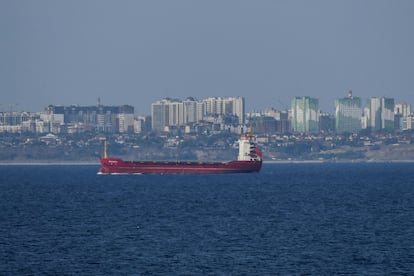Ukraine pushes Russian Black Sea fleet back and opens grain corridor through NATO waters
Last July, Russia broke the Black Sea Grain Initiative, an agreement signed in summer 2022 with Turkey and the UN that allowed Ukrainian grain to be exported to international markets

Kyiv has won a significant battle against Moscow in the Black Sea. Despite the blockade imposed by the Russian fleet, the Armed Forces of Ukraine are keeping enemy warships away from their ports in Odesa province, securing the first leg of a new grain export route through the waters of three NATO countries: Romania, Bulgaria, and Turkey. Ukrainian naval forces reported Wednesday that there are currently 25 merchant ships leaving their ports, waiting to sail, or on their way to leave through them.
Last July, Russia broke the Black Sea Grain Initiative, an agreement signed in summer 2022 with Turkey and the United Nations under which the Kremlin allowed Ukrainian grain to be exported to international markets. Vladimir Putin agreed to the pact under pressure from developing countries, which have suffered from higher prices for commodities such as wheat due to the blockade of Ukraine’s powerful agricultural sector. Putin backed out of the initiative this summer on the grounds that the West had not fully honored its commitment — agreed in a side deal to the one with Ukraine — to lift the embargo on trade in Russian grain and fertilizers.
Kyiv has now demonstrated that it does not need the Kremlin’s authorization to reactivate the export of its grain. Spokesman for the Ukrainian Navy, Dmytro Pletenchuk, has reported that there are currently three merchant ships sailing for Romania from Ukrainian ports. Another 12 will follow the same route in the next few days and a further 10 are heading to Ukraine. Since this safe route was activated on September 19, at least seven freighters have departed from ports in Odesa for international markets. A new development is that Ukraine is also exporting iron ore, as confirmed by Minister for Infrastructure Oleksandr Kubrakov on October 1.
These figures would indicate that Ukraine is reaching the level of merchant traffic it maintained under the UN and Turkey-sponsored agreement, but with the advantage of not having to suffer the constant delays caused by Russian inspectors in giving the go-ahead for vessels to access Ukrainian ports. One of the conditions of the grain initiative was that only agricultural products could be transported. The 25 ships currently on the route, added to the seven that have already left the Black Sea, represent a huge increase in shipping from five that sailed last July from Ukrainian ports under the grain initiative; in June there were 34 and in May, 30, according to UN data.
May, June, and July 2023 saw the least merchant activity under the UN grain initiative. During the year the pact was in place, an average of 83 ships per month sailed from Ukrainian ports. Data provided by the Ministry of Infrastructure states that the first five ships to sail through the new corridor have transported almost 150,000 tons of grain. The next five, Kubrakov said, will total 120,000 tons.
The new sea route has the added guarantee, according to Pletenchuk, that it runs through the waters of NATO countries, which Russia will not dare to attack. But there are almost 90 nautical miles (169 kilometers) that ships must navigate in Ukrainian waters, and these are at the mercy of Russian weapons. The key has been that the Ukrainian Navy has managed to secure a perimeter by pushing Russian warships away. On the one hand, Ukraine has attacked Russian patrol boats and warships with their nautical Neptune missiles and “sea baby” marine drone bombs in operations hundreds of miles from their own bases; on the other, missile shelling of the Russian Black Sea fleet’s base in Sevastopol in occupied Crimea has forced the Kremlin to move most of its ships to safer ports such as Feodosia — also in Crimea, but further away from the grain route — and Novorossiysk in Russia’s Krasnodar province.
Pletenchuk said that so far three Russian ships have been sunk. Since August, Ukrainian strikes have also caused extensive damage to a submarine and a landing ship in Sevastopol, and to a ship in Novorossiysk.
This exodus of ships from Sevastopol has been confirmed by satellite imagery and highlighted in daily British intelligence reports. That Russia is losing control of the Black Sea is borne out by repeated landings of Ukrainian special forces in Crimea, over 130 miles from the free Ukrainian coast. The latest rapid attack operation was confirmed Wednesday by the Defense Ministry, with a video showing at least eight speedboats involved.
Pletenchuk is keen to avoid triumphalism and warned that there are 10 Russian warships in Ukrainian Black Sea waters, although he confirmed that five of them are patrolling in the area of the Kerch bridge. This bridge is critical to Moscow’s logistical chain because it is the only land link connecting Russia to Crimea and provides a route for much of the supplies for troops on the southern front. Ukraine has already twice partially destroyed the bridge, disrupting the timings of Russian military logistics. The Ukrainian Navy spokesman added that there are 10 further Russian warships in the Sea of Azov. These provide logistical support, both in transport and in launching long-distance attacks, to the Russian defenses on the southern front, in the Zaporizhzhia and Kherson regions.
Russian air superiority
The British Ministry of Defence has noted that Russia is opting for attack operations against military targets in the Black Sea with its Air Force, which is less exposed to being hit by defensive fire than its ships. Shelling has also intensified against port infrastructure in Odesa and the Ukrainian port of Izmail, the main departure point for merchant ships sailing up the Danube River to European markets. Reuters reported Wednesday that about 2.4 million tons of grain left Ukraine on the Danube in September. Data from Ukrainian authorities indicate that 50 million tons are available for sale abroad between 2023 and 2024.
The Armed Forces of Ukraine insist that the only way to protect their port cities is with more anti-aircraft defense batteries supplied by the West. Pletenchuk admitted that Russia’s air dominance in the Black Sea will remain undisputed until F-16 fighters are operational in Ukraine. The White House last August gave the green light for the delivery of these aircraft and the first Ukrainian pilots are training to enter combat from 2024.
Sign up for our weekly newsletter to get more English-language news coverage from EL PAÍS USA Edition
Tu suscripción se está usando en otro dispositivo
¿Quieres añadir otro usuario a tu suscripción?
Si continúas leyendo en este dispositivo, no se podrá leer en el otro.
FlechaTu suscripción se está usando en otro dispositivo y solo puedes acceder a EL PAÍS desde un dispositivo a la vez.
Si quieres compartir tu cuenta, cambia tu suscripción a la modalidad Premium, así podrás añadir otro usuario. Cada uno accederá con su propia cuenta de email, lo que os permitirá personalizar vuestra experiencia en EL PAÍS.
¿Tienes una suscripción de empresa? Accede aquí para contratar más cuentas.
En el caso de no saber quién está usando tu cuenta, te recomendamos cambiar tu contraseña aquí.
Si decides continuar compartiendo tu cuenta, este mensaje se mostrará en tu dispositivo y en el de la otra persona que está usando tu cuenta de forma indefinida, afectando a tu experiencia de lectura. Puedes consultar aquí los términos y condiciones de la suscripción digital.
More information
Archived In
Últimas noticias
There is as much life left to discover on planet Earth as that which is already known
Dozens presumed dead, around 100 injured in fire at Swiss Alps bar during New Year’s celebration
Is porn for women different from conventional porn? We spoke to those who make it
Cartagena de Indias is sinking: What can the city do to mitigate it?
Most viewed
- Reinhard Genzel, Nobel laureate in physics: ‘One-minute videos will never give you the truth’
- David King, chemist: ‘There are scientists studying how to cool the planet; nobody should stop these experiments from happening’
- Oona Chaplin: ‘I told James Cameron that I was living in a treehouse and starting a permaculture project with a friend’
- Sinaloa Cartel war is taking its toll on Los Chapitos
- The Interoceanic Train, the Mexican alternative to the Panama Canal











































